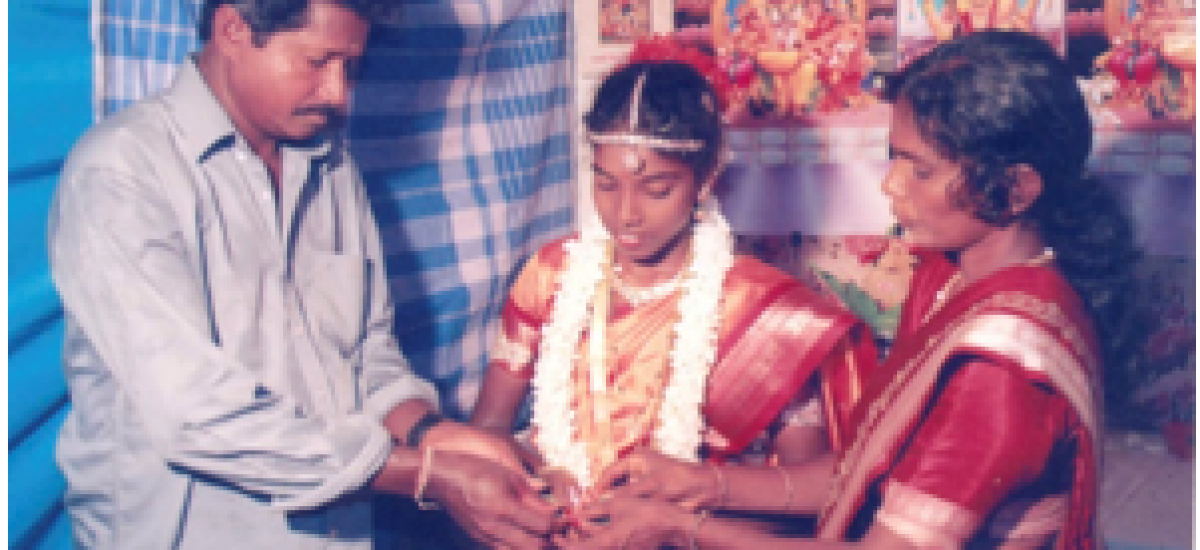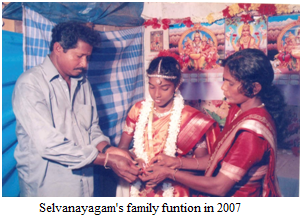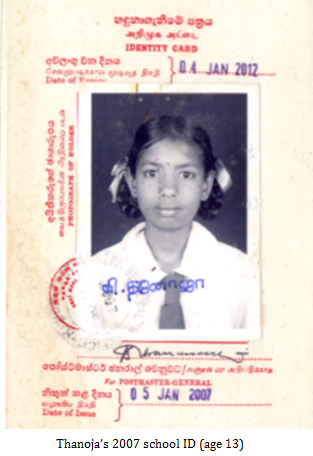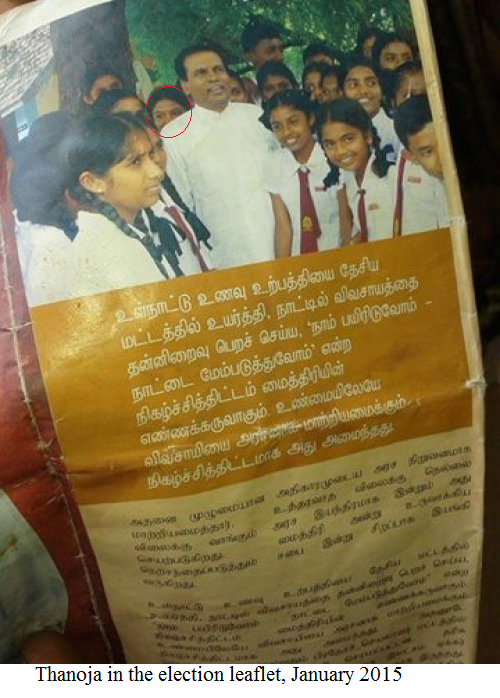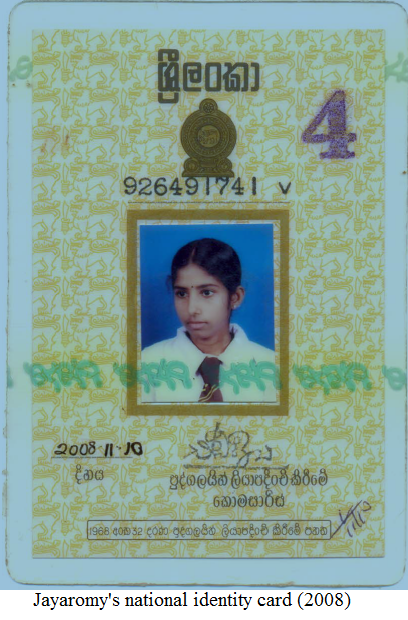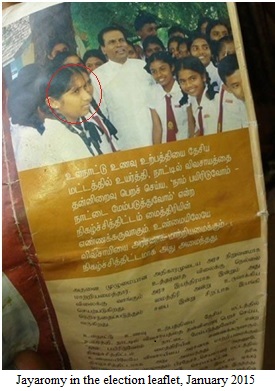While domestic and international observers have been praising the peaceful transfer of power in early January, Sri Lanka’s civil conflict continues and Tamil rights remain in question.
TSA has obtained a series of highly credible reports about people who disappeared during the final days of combat from September 2008 – May 2009. This year, the Government of Sri Lanka failed to publish a progress report on its January 2014 National Plan of Action for the Implementation of the LLRC Recommendations. Shockingly, the new administration has failed to acknowledge the recommendations of the LLRC in any capacity. Against its promises to release long-held conflict-related prisoners, the new leaders have not taken any action. Where is the accountability for disappearances, war crimes, crimes against humanity, the Channel 4 footage, and these recent developments? Where is the meaningful action on reconciliation? Where are the rehabilitation services for the people in the North and East? Where are the answers? Sri Lanka has been in the spotlight recently for a good reason. Some have even gone as far as calling the country South Asia’s most robust democracy, bith thousands of Tamil families waiting for answers, justice, and accountability, who is this “robust” democracy representing anyway?
The situation in the country’s war-torn northern province remains dire and, as this piece shows, much work remains to be done when it comes to human rights, reconciliation, and justice.
Sithamparapillai Selvanayagam
In April 2009 Sithamparapillai Selvanayagam and his family were travelling from an LTTE controlled area into an Army controlled area. During shelling Sithamparapillai Selvanayagam sustained injuries and his family saw the Army load him on to a tractor. The family never heard from him again. They made complaints about his disappearance to the International Committee of the Red Cross (ICRC), Sri Lankan Human Rights Commission, and they searched jails and prisons. In addition, they lodged a complaint at the police station on the 6th of March 2014 and received a receipt of their complaint. The next time the family saw Sithamparapillai Selvanayagam was in an election leaflet in 2015. The family can identify him by several distinguishing characteristics. The Colombo Mirror reported this story on 19 January 2015 and TSA followed up with several conversations with Sithamparapillai Selvanayagam’s family. The family has not received information about the photograph or about Sithamparapillai Selvanayagam’s location since he appeared in the leaflet.
Thanoja Vevakanantham
Thanoja was just 15 at the end of the war in May 2009. She and her family lived in Mulliativu. On 10th May 2009 Thanoja sustained a combat-related injury on her thigh. Her mother saw the Army carrying Thanoja away after the shelling and then never saw her again. Her family reported the disappearance to the Presidential Commission, the Child Protection Authority, the Sri Lankan Human Rights Commission, Joseph Camp, and the ICRC.
More than two years later, in November 2011, the Criminal Investigation Division (CID) contacted the family. The CID gave the family a phone number (0112121839) for information about their daughter. Her mother never called though, because the CID also told the family not to call back – and that the CID would contact the family if they needed information.
In March 2012, the CID made an inquiry about Thanoja with the Grama Sevaka and her school principal. In September 2012, the CID went to Thanoja’s parents’ home to collect information about her father. At the same time the CID called Thanoja’s mother and asked her to provide a letter stating that in 2009 Thanoja was a student. The CID also requested information about the family’s income, property, cows, tractor, and land. Thanoja’s mother provided this information to the CID, but she never received news of her daughter’s location. Then again in 2014, the CID returned to inquire about the family’s properties and for additional detailed information on the father. These visits have given the family a sense of hope and despair for two years between 2012 and 2014.
On 8 January 2015, after the election results, Thanoja’s mother saw her daughter’s picture in an election leaflet. The family returned to the ICRC for information, but they have not heard anything about their daughter. Thanoja’s mother provided this information directly to TSA.
Illegal detention centers
On 20 February 2015, reports confirmed what TSA has heard for years- the Government of Sri Lanka has maintained secret and illegal detention centers. A Tamil National Alliance Parliamentarian announced, “Over 700 people have been detained without any outside links at Gota Camp in Trincomalee.” According to this Parliamentarian, the Government continues to hold at least 35 unidentified families. http://www.colombomirror.com/?p=2521#more-2521
TSA has also received eyewitness accounts from survivors of these detention centers. One eyewitness told TSA that the Government of Sri Lanka held fifteen prisoners in the Trinco Navy Head Quarters from April 2009 – June 2012. For three years, the eyewitness and his fellow prisoners only had outside contact with the military intelligence from Joseph Camp in Vavuniya. The Government did not send them to a rehabilitation camp or tell their families that the prisoners were alive and in detention.
The Government finally informed the prisoners’ family members about the detention in June 2012 and subsequently took the prisoners to Maruthamadu, Chettikulam Rehabilitation Centre for six months before releasing them.
TSA cannot provide the eyewitness’ full account of this unauthorized detention facility because the prisoners were threatened with death if they exposed the truth.
Jayaromy
The LTTE forcibly conscripted Jayaromy, daughter of Kasipillai and Jeyavanitha on 4th March 2009 at Irattaivaikkal. Jayaromy was the oldest child and the only person in the family involved with the LTTE. On 20 March 2009 the Army did a round-up of LTTE soldiers in Irattaivaikkal. An eyewitness who subsequently died during shelling told Jeyavanitha that Jayaromy had been captured during the round-up. Jeyavanitha reported the disappearance to the Presidential Commission, the ICRC, and Human Rights Commission at Vavuniya.
In 2010, after the government resettled the family in Mullaitivu, the CID would visit their home every time they passed to discuss Jayaromi’s disappearance. In mid 2014, a nun from Vavuniya gave Jayaromy’s mother a phone number to call for information about her daughter. Jeyavanitha discovered that her daughter was studying in Colombo at a school where the principal spoke Tamil. Just before she left for Colombo to meet her daughter, the principal of the school called and reported that they had confused another girl from Jaffna with Jayaromy.
Jeyavanitha regularly participates in protests and meetings to demand action and accountability for the disappeared. In February 2015, Jeyavanitha saw a photograph of her daughter with Maithiripala Sirisena on an election leaflet. The picture also appeared in the Virakesari Newspaper. On 6 & 15 February 2015[1], the CID asked for a copy of the leaflet, but Jeyavanitha refused to hand over the only clue to her daughter’s location.
The Government of Sri Lanka has failed to implement LLRC recommendations on disappearances, ignoring justice and devastating families
Thousands of devastated families have waited far too long for the truth about their missing loved-ones. The Lessons Learnt and Reconciliation Commission (LLRC) attempted to address their needs in its final report with a range of recommendations pertaining to disappearances[2]:
9.46: “The Government therefore is duty bound to direct the law enforcement authorities to take immediate steps to ensure that these allegations are properly investigated into and perpetrators brought to justice.”
9.48: “A comprehensive approach to address the issue of missing persons should be found as a matter of urgency …”
9.49: “The…relatives of missing persons shall have the right to know the whereabouts of their loved ones. They also have the right to know the truth about what happened to such persons, and to bring the matter to closure.”
9.50: “All efforts should be made…to trace the whereabouts of the missing persons and ensure reunification with their families. The families should be kept informed of the progress being made...”
9.51: “…the Commission recommends that a Special Commissioner of Investigation be appointed to investigate alleged disappearances…”
9.58: “The families need to be assisted to deal with the trauma of not knowing the whereabouts of their family members…They could also be assisted financially in situations where the missing persons had been the breadwinners. Legal aid should also be provided…”
TSA highlighted these recommendations as high priority needs in its 2012 report, A LLRC Shadow Action Plan.[3] In 2013, TSA published data[4] collected from over 1,500 respondents in the North, East, and Nuwara Eliya showing that 23% of survey respondents had at least one family member who was disappeared, with almost half (45.5%) of those respondents indicating that their relative disappeared between September 2008 and May 2009. Respondents knew that State Security Personnel was responsible for 77% of disappearances, and reported that just 2% of all disappearance cases had been investigated.
Illustrating the Government of Sri Lanka’s apathetic approach to the LLRC recommendations, only 7% of respondents with disappeared relatives had received psychosocial assistance, 63% of respondents had never heard about the Special Investigation Commission, and 75% of Respondents had never heard of Information Centers for disappeared people.
Just 13% of respondents who should have received compensation for a disappeared family member actually received compensation in 2013. Data published by TSA in 2014 shows that almost 75% of relatives with disappeared family members still require compensation. Data from the same year also shows that 60% of families with disappeared relatives had not received adequate livelihood assistance.
TSA’s most recent data from 2015 shows that of 23% of respondents who have at least one disappeared family member, just one respondent received any psychological assistance to deal with the trauma and just two respondents received adequate livelihood assistance for disappearance. The previous administration made zero progress on the LLRC recommendations related to disappearances. The new administration’s initial decisions and response to these emerging stories will determine whether reconciliation and justice can be a reality in Sri Lanka.
Conclusion
The Rajapaksa regime ignored the LLRC recommendations; that’s not in dispute. What people are waiting to see is if the Sirisena administration will behave any differently.
To ensure its commitments to reconciliation and rehabilitation, the Government of Sri Lanka must investigate and report on these chilling developments regarding the disappeared. The violence of the war has not ended for these families who experience immense pain, desperation, and powerlessness every day. The Government of Sri Lanka must take immediate steps to implement the LLRC’s recommendations regarding disappeared people. The United Nations and the international community must demand action and accountability. Tamil people and their allies must continue to seek out and to expose the truth. The Human Rights Council has recently shown that it’s willing to give the Sirisena administration the benefit of the doubt, but the time for meaningful action has arrived.
So, whose democracy is it anyway? The war ended nearly six years ago, but the urgent needs of the Tamil community still haven’t been met. If the new government in Colombo won’t take heed now, what does that say about democracy in Sri Lanka?
[1] http://epaper.virakesari.com:8080/home/index?editionId=13&editionDate=06/02/2015 page 14
[2]http://www.priu.gov.lk/news_update/Current_Affairs/ca201112/FINAL%20LLRC%20REPORT.pdf
[3] http://www.tsasouthasia.org/eng/reports/giving-reconciliation-in-sri-lanka-a-better-chance-a-shadow-action-plan-for-the-llrc/
[4] http://www.tsasouthasia.org/eng/category/reports/

